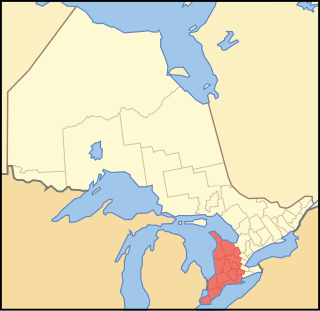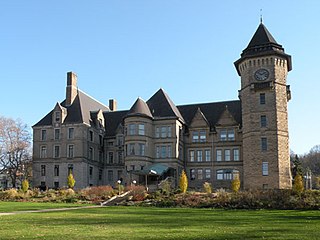Related Research Articles

Erie is a city on the south shore of Lake Erie and the county seat of Erie County, Pennsylvania, United States. It is the fifth-most populous city in Pennsylvania and the most populous in Northwestern Pennsylvania with a population of 94,831 at the 2020 census. The Erie metropolitan area, equivalent to all of Erie County, had a population of 270,876 in 2020. Erie is located about 80 miles (130 km) from Buffalo, 90 miles (140 km) from Cleveland, and 120 miles (190 km) from Pittsburgh.

GE Transportation is a division of Wabtec. It was known as GE Rail and owned by General Electric until sold to Wabtec on February 25, 2019. The organization manufactures equipment for the railroad, marine, mining, drilling and energy generation industries. The company was founded in 1907. It is headquartered in Pittsburgh, Pennsylvania, while its main manufacturing facility is located in Erie, Pennsylvania. Locomotives are assembled at the Erie plant, while engine manufacturing takes place in Grove City, Pennsylvania. In May 2011, the company announced plans to build a second locomotive factory in Fort Worth, Texas, which opened in January 2013.

The Northern Tier is a geographic region consisting of five rural counties in north-central Pennsylvania.

Southwestern Ontario is a secondary region of Southern Ontario in the Canadian province of Ontario. It occupies most of the Ontario Peninsula bounded by Lake Huron, including Georgian Bay, to the north and northwest; the St. Clair River, Lake St. Clair, and Detroit River, to the west; and Lake Erie to the south. To the east, on land, Southwestern Ontario is bounded by Central Ontario and the Golden Horseshoe.

The Westinghouse Air Brake Technologies Corporation was an American company founded on September 28, 1869 by George Westinghouse in Pittsburgh, Pennsylvania. Earlier in the year he had invented the railway air brake in New York state.
An urban enterprise zone is an area in which policies to encourage economic growth and development are implemented. Urban enterprise zone policies generally offer tax concessions, infrastructure incentives, and reduced regulations to attract investments and private companies into the zones. They are a type of special economic zone where companies can locate free of certain local, state, and federal taxes and restrictions. Urban enterprise zones are intended to encourage development in deprived neighborhoods through tax and regulatory relief to entrepreneurs and investors who launch businesses in the area.

This article describes the use and availability of biodiesel in various countries around the world.
The economy of Lethbridge is central to the commercial, distribution, financial and industrial sectors of the southern Alberta economy. Lethbridge has a trading area population of 250,000. The city was founded in 1885 as a result of local coal mining and later was buoyed by local farming and ranching. Toward the end of the twentieth century, the local economy started diversifying by focusing more on service-based industries.

The Youngstown–Warren, OH Metropolitan Statistical Area, typically known as the Mahoning Valley, is a metropolitan area in Northeast Ohio with Youngstown, Ohio, at its center. According to the U.S. Census Bureau, the metropolitan statistical area (MSA) includes Mahoning and Trumbull counties. As of the 2020 census, the region had a population of 430,591, making it the 125th-largest metro area in the country.

The economy of Pittsburgh, Pennsylvania is diversified, focused on services, medicine, higher education, tourism, banking, corporate headquarters and high technology. Once the center of the American steel industry, and still known as "The Steel City", today the city of Pittsburgh has no steel mills within its limits, though Pittsburgh-based companies such as US Steel, Ampco Pittsburgh and Allegheny Technologies own several working mills in the Pittsburgh metropolitan area.

The economy of Omaha, Nebraska is linked to the city's status as a major commercial hub in the Midwestern United States since its founding in 1854. Dubbed the "Motor Mouth City" by The New York Times, Omaha is widely regarded as the telecommunications capital of the United States. The city's economy includes agriculture, food processing, insurance, transportation, healthcare and education. Warren Buffett of Berkshire Hathaway has lived in Omaha all of his life, as have the ConAgra Foods, Union Pacific Railroad and Mutual of Omaha Companies, and Kiewit Corporation, all Fortune 500 corporations.

A green-collar worker is a worker who is employed in an environmental sector of the economy. Environmental green-collar workers satisfy the demand for green development. Generally, they implement environmentally conscious design, policy, and technology to improve conservation and sustainability. Formal environmental regulations as well as informal social expectations are pushing many firms to seek professionals with expertise with environmental, energy efficiency, and clean renewable energy issues. They often seek to make their output more sustainable, and thus more favorable to public opinion, governmental regulation, and the Earth's ecology.

The economy of Ohio nominally would be the 20th largest global economy behind Turkey and ahead of Switzerland according to The World Bank as of 2022. The state had a GDP of $822.67 billion in 2022, which is 3.23% of the United States total, ranking 7th in the nation behind Pennsylvania and ahead of Georgia. In 2013, Ohio was ranked in the top ten states for best business climate by Site Selection magazine, based on a business-activity database. The state was edged out only by Texas and Nebraska for the 2013 Governor's Cup award from the magazine, based on business growth and economic development.

Westinghouse Air Brake Technologies Corporation, commonly known as Wabtec, is an American company formed by the merger of the Westinghouse Air Brake Company (WABCO) and MotivePower Industries Corporation in 1999. It is headquartered in Pittsburgh, Pennsylvania.

The use of biofuels varies by region. The world leaders in biofuel development and use are Brazil, United States, France, Sweden and Germany.

The economy of the state of Indiana is reflected in its gross state product in 2017 of US$359 billion and per capita income of $44,165. A high percentage of Indiana's income is from manufacturing. Indiana has been the largest steel producing state in the U.S. since 1975, with the Calumet Region of northwest Indiana being the largest single steel producing area in the U.S., accounting for 27% of all U.S. steel production. Indiana is also the 2nd largest auto manufacturing state. Indiana's other manufactures include pharmaceuticals and medical devices, automobiles, electrical equipment, transportation equipment, chemical products, rubber, petroleum and coal products, and factory machinery.
Pennsylvania Department of Community and Economic Development is a cabinet-level state agency in Pennsylvania. The mission of the department is to enhance investment opportunities for businesses and to improve the quality of life for residents. The department works to attract outside corporations, spur expansion of existing local employers, and foster start-ups by providing tax incentives and technical assistance. Additionally, the agency provides grant funding to community groups and local governments for projects such as revitalizing "Main Street" infrastructure, enhancing low income housing availability, or improving access to technology.

The energy sector of Ohio consists of thousands of companies and cities representing the oil, natural gas, coal, solar, wind energy, fuel cell, biofuel, geothermal, hydroelectric, and other related industries. Oil and natural gas accounts for $3.1 billion annually in sales while ethanol generates $750 million. Toledo is a national hub in solar cell manufacturing, and the state has significant production of fuel cells. In 2008, the state led the country in alternative energy manufacturing according to Site Selection Magazine, while the natural gas industry has experienced growth due to the expansion of shale gas.

The Buffalo area economy consists of a mix of industrial, light manufacturing, high technology, and service-oriented private sector companies. Instead of relying on a single industry or sector for its economic future, the region has taken a diversified approach that has the potential to create opportunities for growth and expansion in the 21st century.
MotivePower, Inc. (MPI) was an American manufacturer of diesel-electric locomotives. The company traces its history back to being a division of Morrison-Knudsen (MK) since 1972. After MotivePower spun-off from MK, the company merged to the air brake manufacturer WABCO to form "Wabtec" in 1999, remaining as a brand of it.
References
- ↑ Erie, PA Economy at a Glance. (n.d.). Retrieved April 05, 2017, from https://www.bls.gov/eag/eag.pa_erie_msa.htm
- ↑ Erie Regional Chamber and Growth Partnership. "Major Employee Groups". Archived from the original on 2007-02-10. Retrieved 2007-05-21.
- ↑ "Wabtec to Close Locomotive Manufacturing Company in Boise, Consolidate Operations into Erie Site". www.erienewsnow.com. Retrieved 2021-01-03.
- ↑ "The Plastek Group" . Retrieved 2007-05-25.
- ↑ "Erie Insurance Group" . Retrieved 2007-05-25.
- ↑ McNeel, Rick. "Lord Corporation History". Archived from the original on 2007-06-06. Retrieved 2007-05-25.
- ↑ Erie Chamber of Commerce. "Fact Sheet". Archived from the original on 2013-01-11. Retrieved 2007-05-21.
- ↑ "Lake Erie Biofuels". Archived from the original on 2007-04-24. Retrieved 2007-05-21.
- ↑ Palatiella, Ed, Revised LERTA plan: Shorten program, target blighted areas, Erie Times-News, 6 May 2007, pp 1A, 8A
- ↑ YourErie.com. "Mayor Announces Lerta Plan" . Retrieved 2007-05-21.[ dead link ]